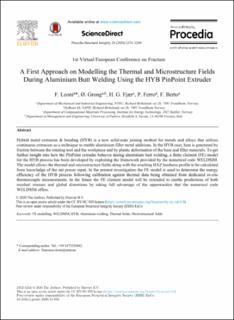| dc.contributor.author | Leoni, Francesco | |
| dc.contributor.author | Grong, Øystein | |
| dc.contributor.author | Fjær, Hallvard Gustav | |
| dc.contributor.author | Ferro, Paolo | |
| dc.contributor.author | Berto, Filippo | |
| dc.date.accessioned | 2021-01-13T08:47:56Z | |
| dc.date.available | 2021-01-13T08:47:56Z | |
| dc.date.created | 2020-12-08T13:49:46Z | |
| dc.date.issued | 2020 | |
| dc.identifier.citation | Procedia Structural Integrity. 2020, 28 2253-2260. | en_US |
| dc.identifier.issn | 2452-3216 | |
| dc.identifier.uri | https://hdl.handle.net/11250/2722699 | |
| dc.description.abstract | Hybrid metal extrusion & bonding (HYB) is a new solid-state joining method for metals and alloys that utilizes continuous extrusion as a technique to enable aluminium filler metal additions. In the HYB case, heat is generated by friction between the rotating tool and the workpiece and by plastic deformation of the base and filler materials. To get further insight into how the PinPoint extruder behaves during aluminium butt welding, a finite element (FE) model for the HYB process has been developed by exploiting the framework provided by the numerical code WELDSIM. The model allows the thermal and microstructure fields along with the resulting HAZ hardness profile to be calculated from knowledge of the net power input. In the present investigation the FE model is used to determine the energy efficiency of the HYB process following calibration against thermal data being obtained from dedicated in-situ thermocouple measurements. In the future the FE element model will be extended to enable predictions of both residual stresses and global distortions by taking full advantage of the opportunities that the numerical code WELDSIM offers. | en_US |
| dc.language.iso | eng | en_US |
| dc.publisher | Elsevier | en_US |
| dc.rights | Navngivelse 4.0 Internasjonal | * |
| dc.rights.uri | http://creativecommons.org/licenses/by/4.0/deed.no | * |
| dc.title | A First Approach on Modelling the Thermal and Microstructure Fields During Aluminium Butt Welding Using the HYB PinPoint Extruder | en_US |
| dc.type | Peer reviewed | en_US |
| dc.type | Journal article | en_US |
| dc.description.version | publishedVersion | en_US |
| dc.source.pagenumber | 2253-2260 | en_US |
| dc.source.volume | 28 | en_US |
| dc.source.journal | Procedia Structural Integrity | en_US |
| dc.identifier.doi | 10.1016/j.prostr.2020.11.058 | |
| dc.identifier.cristin | 1857483 | |
| dc.description.localcode | © 2020 The Authors. Published by Elsevier B.V. This is an open access article under the CC BY-NC-ND license (https://creativecommons.org/licenses/by-nc-nd/4.0) | en_US |
| cristin.ispublished | true | |
| cristin.fulltext | original | |
| cristin.qualitycode | 1 | |

